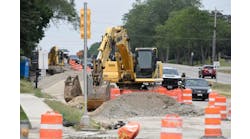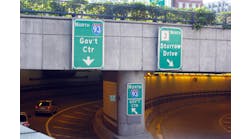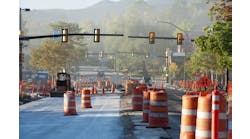Despite more than tripling in population over the last 30 years, the town of Matthews, nestled just outside of Charlotte on the southeastern edge of Mecklenburg County, N.C., has managed to preserve its allure as a small town retreat from the big and bustling city.
In recent years, Matthews has made significant improvements to its downtown area with the goal of enhancing the town’s laid-back tempo and quaint historical charm. Recent upgrades to Trade Street, the main street through the downtown historic district, serve as the final fillip in the revitalization.
More than just a Stump
Established in the early 1800s, Matthews was originally known as Stump Town after settling farmers cleared the land to grow cotton, leaving only tree stumps in the once rolling woodlands. The town slowly grew over the next 70 years, with cotton and timber fueling its expansion. A stagecoach depot, post office, store and sawmill supported the growing businesses and homes, and by 1825 the name Stump Town eventually gave way to Fullwood, the name of the area postmaster.
In 1874, the Central Carolina Railroad came to the area, and just like most railroad towns of that century, the settlement quickly began to flourish and trade with other cities. The railroad named the stop Matthews Station after former railroad director Edward Watson Matthews, and the area soon became known as Matthews. The town was officially incorporated in 1879 with only 191 residents.
Ralph Messera, the town’s current public works director who came to Matthews in 1997, said the area grew slowly at first but then rapidly expanded over the last half-century as a major suburb of Charlotte.
“In 1970, Matthews had only 798 people. But by 1980, it grew to 8,000 people; by 1990, it had 13,000; by 2000, it had 22,000, and now we’re at 28,000,” said Messera, running down the census data from those years. “It’s mostly residential, but downtown was sort of odd; we had a town with 20,000-plus residents, but still had the downtown of a town of only 1,000 people.”
Like many other suburbs in the area, Matthews is made up of mostly subdivisions whose residents commute to the larger nearby cities of Charlotte or Monroe. However, over the years when urban sprawl mostly took the form of “anywhere USA” franchise development, Matthews succeeded in keeping its historic and small-town charm.
Despite its rapid growth, the town still boasts a prominent downtown center, full of life and peppered with 100-year-old buildings that define the area’s distinct character. The Matthews Commercial Historic District is listed in the National Register of Historic Places and features 10 buildings from the late 19th and early 20th centuries, seven of which face Trade Street, the main street through the center of downtown. Renfrow Hardware, one of its oldest, was established in 1900 and is still in operation today. Others include the Victorian-style Reid House, built in 1890, which is now used for special events, as well as the traditional brick-style Funderburk General Merchandise store, which still has its original tin ceiling.
Doubling downtown
Matthews’ unique identity as a small historic town was exactly what residents sought to preserve when town officials developed a downtown master plan in 1997 and later a shared vision in 2005. Key principles included creating a more pedestrian-friendly environment, extending the downtown street grid and providing more parks and open spaces that would maintain and enhance the town center.
One of the first projects was a public-private venture that nearly doubled the size of downtown.
According to Messera, “Matthews’ downtown in 1999 was simply the two-block area of the historic district.”
As part of a massive downtown revitalization project, starting in 2000, the town bought a former shopping center and created a new road called Matthews Station Street. The project included the construction of a town square with a gazebo and seating areas, four large buildings to house multiple retail tenants and a Town Hall and Library.
“Although everything along the street is new, the buildings were designed to be reminiscent of the surrounding historic buildings,” said Messera. “We also relocated the original 1880 train station to the area.”
Messera said improvements along Trade Street, which now intersects Matthews Station Street, also were an essential part of this plan.
“Trade Street runs right through the old part of downtown,” he remarked. “It experiences a lot of commuting and local traffic, averaging 16,000 to 17,000 vehicles a day.”
A primary goal was to improve pedestrian safety and mobility, which meant slowing traffic along Trade Street and redirecting commuters to collector roads, such as John Street or Fullwood Lane. Both alternatives connect to the Matthews Township Parkway, which links to U.S. Highway 74, the main corridor leading 10 miles northwest into Charlotte and 15 miles southeast into Monroe.
According to Messera, Trade Street was a four-lane corridor with head-in parking on one side and parallel parking on the other. Then in 2000, around the time of the construction of Matthews Station Street, one lane was dropped from the northbound direction and the parallel parking was replaced with more head-in parking.
“There was a plus in that it did slow traffic a little and allowed us to do a little more pedestrian orientation,” said Messera. “But we wanted to do more for pedestrian movement.”
Specifically, the town wanted to introduce a slightly raised crosswalk opposite the hardware store as one way to further slow traffic. This required transferring control of the two-block downtown section of Trade Street from the North Carolina Department of Transportation to the town, said Messera, which occurred in 1998.
“We also had a problem with the head-in parking spaces,” said Messera. “When the spaces were empty, people had the idea to drive down them as if they were an extra lane.”
It was a safety concern for not only pedestrians crossing the street, but also drivers making right turns, as he recalls once coming close to an accident himself while turning onto Charles Street as another driver came up on his right using the empty parking spaces as a makeshift lane.
Trade Street was also beginning to show its age, said C.J. O’Neill, town engineer responsible for the improvement project.
“There was a lot of alligator cracking, map cracking and other signs of distress through the pavement. It was just starting to look rundown and needed a facelift.”
With the goals of safety, walkability and overall aesthetics in mind, the town began planning additional improvements to Trade Street, commissioning RS&H as lead designer.
According to O’Neill, key features of the project included adding concrete bump-outs, or raised islands, along the street that would not only delineate the parking spaces, but also minimize the distance pedestrians had to travel to cross the roadway. Since the bump-outs were at least 6 in. above grade, pedestrians were more visible as they approached the crosswalks. The team also added LED lights to the raised crosswalk to warn drivers of crossing pedestrians.
Perhaps the most challenging aspect of the project, said Chad Critcher, vice president of RS&H, was implementing these improvements while preserving as much of the existing infrastructure as possible.
“It was a serious retrofit, and we strived to minimize impacts to the existing features that didn’t need to change, such as the drainage and sidewalk areas,” said Critcher. “We were trying to do a lot for pedestrians and improve the channelization of the traffic, but on a very small budget.”
With a construction budget of only $300,000, the team saved most of the existing pavement area, only resurfacing and restriping the roadway to direct traffic into certain lane arrangements that would ultimately reduce speeds and improve safety. The team also designed a grating system over the original curb and gutter and drainage inlets to allow for the construction of the raised bump-outs while retaining these existing features.
“The sidewalk was only replaced in some sections that needed repair. We also made the raised crosswalk a little more abrupt to help slow traffic. They’re relatively small changes that have made a big impact,” said Critcher.
Enhanced signage and pavement striping improved the left-turn movements onto other streets and into the head-in parking spaces. It also increased safety through the intersection of Trade Street and the railroad, now a CSX track, as 12 to 15 trains still run through the small town each day.
RS&H’s ultimate design also included a median through the length of the street; however, business owners objected to this concept, which would have prevented drivers from making left turns into the parking spaces, said Messera. The town opted for the interim design without the median.
A funding finish
Design of the Trade Street improvements was completed in 2008, but almost immediately the project was put on hold due to lack of funding. Then in 2009 the town received $550,000 through the American Recovery and Reinvestment Act and was able to implement the improvements, as well as an adjacent shovel-ready repaving project along Matthews-Mint Hill Road just north of the downtown area. The total cost for both projects was $611,000.
The projects were combined and awarded to Boggs Paving Inc. of Monroe in 2010. Construction lasted from March through July that year.
“For both projects, the contractor used warm-mix asphalt, which uses less energy and lasts longer [than traditional hot-mix asphalt],” said O’Neill. The old asphalt that was removed was recycled.
O’Neill said the raised bump-outs, probably the most visible change along Trade Street, also allow more landscaping through the area, which has given new life to the town’s main street.
“Before, when we didn’t have bump-outs, it was mostly pavement through the entire two-block area,” said O’Neill. “The bump-outs gave us an area where we could put in smaller trees and shrubbery, flowers and other plantings, which make the street look a lot nicer. It really softens the area.”
According to Ralph Ramsaur, the town’s landscape manager, the team originally planted River Birch trees along the street, since construction of the improvements took place over the summer, and River Birch is a relatively hardy, quick-growing tree. However, these trees were only temporary, and in January this year the town removed and relocated them to the new Four Mile Creek Greenway just south of downtown so that Lace Bark Elms could be planted there instead. Lace Bark Elms, said Ramsaur, can better withstand the soil conditions along Trade Street and will eventually provide more canopy shade.
Each year, from June through October, the town also installs hanging flower baskets and plants flowers in the beds along Trade Street as part of an annual beautification program. “It’s completely funded by the town and really enhances the businesses in downtown,” Ramsaur said.
The recent revitalization of Trade Street marks the final touch in the town’s overall master plan to make downtown Matthews a “special place to live, work and raise a family,” as celebrated on the town’s website and other promotional material.
“Sometimes you forget that it’s all part of the same goal, that it all takes time, but everything is coming together very nicely,” said Communications Director Annette Privette-Keller, looking back over the last several years of improvement projects.
In addition to the downtown redevelopment project nearly 10 years ago, the town recently built a new “pocket park” adjacent to Town Hall on Matthews-Mint Hill Road. The space features benches, a pergola and plenty of flowers and trees, said Privette.
The Four Mile Creek Greenway, a $1.6 million joint project with Mecklenburg County, also recently opened and is continuing to bring even more people to downtown.
Privette said one of the busiest days for downtown is the weekly farmers’ market, which is held every Saturday, as well as Wednesdays during part of the summer. Matthews also is home to one of the nation’s largest Labor Day parades and festivals, and Trade Street is at the center of it all, thus the improvements have made a significant impact on the community.
“Trade Street is so important for all of these events,” said Privette. “It’s really ‘our place to be,’ and the recent improvements make all the difference.”


